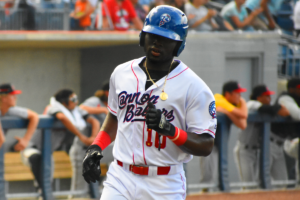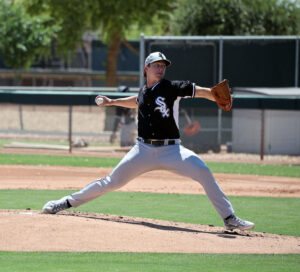Prospect Focus – Alec Hansen, with video and quotes
One of the most intriguing prospects Rob and I caught on our affiliate tour was right-hander Alec Hansen. What follows is an in-depth look at one of the top pitching prospects in the White Sox system, including video and some quotes from both Hansen and his pitching coach, Matt Zaleski.
Background
Alec is a native Coloradoan, and was originally drafted in the 25th round in 2013 out of Loveland High School. He didn’t sign and elected to go to Oklahoma, where he spent his freshman year seeing only minimal action out of the bullpen. The tall righty broke out in his sophomore campaign, getting national attention and being discussed as a potential top five overall pick in the 2016 draft.
That didn’t come to fruition, as Hansen struggled mightily with control and was eventually relegated back to the bullpen during his junior season. Talking with Hansen about his college experience, when asked about his struggles, he didn’t point at anything mechanical. It was about confidence and trust in his view:
To be honest, we’ve worked on a couple things, but I don’t think a lot has changed. I think looking at college, it was more my confidence. What’s changed is the confidence the coaching staff has in me here, allowing me to just pitch and work through trouble. Just that they had the confidence in me, and the players had confidence in me as well. I mean, you have to have confidence in me to take me in the 2nd round like that, after the season I had.
White Sox scouts saw through the numbers and bored in on the talent, surprising some in national publications by not only selecting Hansen in the 2nd round but signing him for a slot bonus. He spent most of his pro debut with Great Falls, where he worked with pitching coach Matt Zaleski (who is now his PC at Kannapolis) and found a touchstone. Across both rookie affiliates and Class A Kannapolis, Hansen posted a 1.32 ERA, 0.81 WHIP, allowed just 24 hits and struck out a whopping 81 in 54.2 innings. Possibly most encouraging, he walked just 3.3 batters per 9 innings and didn’t throw a wild pitch in his 12 starts.
Where he stands today
Alec is a physically imposing man, listed at 6’7″ and 235 pounds. Having spent time talking with him up close, and confirming with others around him, there is confidence he is actually taller than that listed height. Combine that with a high-waisted build, and the first thing you see is impossibly long legs. This isn’t a rail-thin, Chris Sale build either – there is obvious strength on his frame, though he will still probably fill out further as he develops.
His delivery starts with a slow rock and high leg kick, before going into the prototypical Sox-taught “Tall and Fall”. He’s slow to the plate from both the windup and the stretch (more on that later). Despite his size and early stage of development, he seemed to repeat quite well.
In the game we saw in person, Hansen was starting on a relatively chilly evening against a pretty decent Asheville Tourists lineup that had already seen him once this season. Despite all those caveats, he didn’t allow a hit until one out into the 5th inning. Things started to come apart a bit after that.
How did he look? Let’s start with the Alec Hansen of the first four innings:
- Fastball: mostly 93-96, touched 97 once, but also a couple lower than the primary range. Has a little cut-like action, which surprised me in that band.
- Curveball: Hansen’s strongest offspeed pitch comes in at 77 to 81. It’s got enough loop to it that it can be spotted early and there is some signalling, but it usually showed nice shape and quite a bit of drop.
- Change-up: Had a broader band from 82 to 87, doesn’t move a ton but has a slight fade and the speed differential works well. Delivery doesn’t change so it’s not obviously telegraphed, though review of the video shows there is some very slight arm slowing with it.
- Slider: Rarely offered in the first few frames – I had one at 84 and one at 85. Had some nice snap to it though.
- Here are some full at-bat videos from the early innings:
Second inning strikeout…
Second inning weak groundout, including Hansen fielding it…
Hansen told me that his change-up was his strongest current pitch, pointing out that he didn’t think anyone had hit it yet. To wit, this quote from Zaleski about the change:
We challenged Alec in instructs to improve his change-up and credit to him, he put the work in and improved. He had some starts where we made him go fastball-change-up and helped him get the feel for it. He came back into ST with a tremendous feel for it and pretty happy with the velo on it. It’s not 89-90 like it could be, but more around 83-86. As long he keeps his delivery tempo the same, I think hitters are going to have a lot of trouble squaring up.
That combo was plenty to keep Asheville’s lineup stymied. But starting a bit in the 4th, then much more in the 5th and 6th, he began to tire and his pitches changed noticeably. This isn’t a surprise as he adjusts to the rigors of full season ball and long innings – in fact it is quite common at this level. But here is what he looked like in innings 5 and 6:
- Fastball ran more 91-93, touched 94 a couple times, and the movement wasn’t as profound
- Curveball was left up more often, and he started using it less
- Change-up didn’t change in character, but because the fastball dropped the velo diff was less pronounced
- He started using the slider more, in the 81-84 range, and it was his most effective pitch in those later frames
- Here are some videos from the later innings:
Fifth inning, ends in flyout:
Sixth inning, ends in groundout
There was a telling moment in the 5th inning. While in a jam, for the first time in the game we saw Hansen shake off catcher Seby Zavala (and he did it twice for one pitch). He delivered a slider for a strikeout to end the threat. I asked Alec about that moment, and he had this to say:
On 3-2, right? Yeah I remember that. I used to throw my slider a lot more than my curveball. But I feel like my curveball plays better, and I can throw it for a strike more often, so I think it’s a better pitch than my slider. But my curveball’s not always there – my feel for it – and my slider I’ve usually got a pretty good feel for. So I just felt more comfortable going to the slider then, than the curve.
Zaleski added further color when we interviewed him:
He held his curveball through the first three and it was dominant. He lost feel for it right around half-way through the fourth and its something that I talked to him and Seby (Zavala) about, if you notice that pitch is starting to go, its not something you want to throw in a big situation.
The tiring in later innings is something to keep in mind, but it’s not a big worry. The biggest issue we saw was with the running game. Hansen is very slow to the plate, and his pick-off move could charitably be called a “show me” offering. As a result, runners have been going at will in his last few starts. In his last three contests, he’s allowed 15 stolen bases in 15.2 innings with no one caught. Watching a game where this happened six times, it was clear that Zavala had no chance on most of the runners. As an illustration, Zavala has thrown out just 1 of 20 attempted base stealers while working with Hansen, but nailed 7 of 16 with every other pitcher he’s caught.
I asked Hansen about the running game, and this was his response:
It’s not something we just blow off of course. I see that guys are stealing on me all the time. But right now, mostly, it’s just trying to tackle one thing at a time. I’m trying to get all my pitches down, throw a lot of strikes. Just focus on myself right now, and attacking hitters rather than the running game. Once I’ve completed those things that I’m working on right now, then I’ll focus more on the running game.
So he’s aware, they are talking about it, but it just isn’t a priority for him right now. The White Sox are clearly focused on getting Hansen right as a thrower first, which makes sense (though in the meantime, I hope Alec takes Seby out for dinner at some point). As a positive indicator of his ability to make those adjustments later, he does show good athleticism (especially for his frame) when fielding the position.
Overall View
Alec Hansen is a project, but one that has already reached some key milestones. This is not a pitcher likely to rush up the system like, for example, Dane Dunning. The 22-year old 2nd rounder needs to build up endurance, modify his delivery from the stretch, and do some work to attenuate the running game.
The talent is undeniable. His fastball is already plus, he throws strikes and repeats his delivery well, and all his offspeeds show major league potential. It’s not crazy to say his ceiling is a number 2 starter, and that he’s got a reasonable shot at sticking in the middle of a rotation in the majors. A high leverage reliever floor is pretty solid at this point. Just don’t expect him in the next couple years.
Want to know right away when we publish a new article? Type your email address in the box on the right-side bar (or at the bottom, if on a mobile device) and click the “create subscription” button. Our list is completely spam free, and you can opt out at any time.







